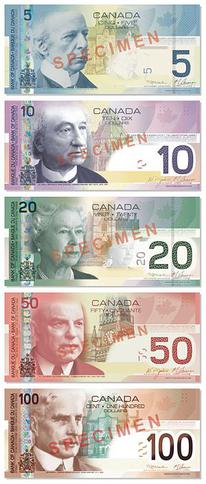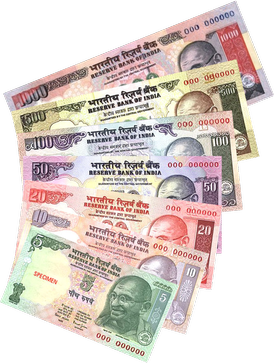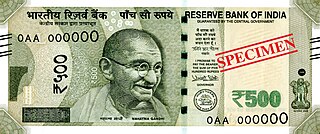The Kwacha is the currency of Zambia. It is subdivided into 100 Ngwee.

The krone is the official currency of Denmark, Greenland, and the Faroe Islands, introduced on 1 January 1875. Both the ISO code "DKK" and currency sign "kr." are in common use; the former precedes the value, the latter in some contexts follows it. The currency is sometimes referred to as the Danish crown in English, since krone literally means crown. Historically, krone coins have been minted in Denmark since the 17th century.

The United States five-dollar bill ($5) is a denomination of United States currency. The current $5 bill features a portrait of Abraham Lincoln, the 16th U.S. president (1861-1865), on the front and the Lincoln Memorial on the back. All $5 bills issued today are Federal Reserve Notes.

The United States one-hundred-dollar bill ($100) is a denomination of United States currency. The first United States Note with this value was issued in 1862 and the Federal Reserve Note version was launched in 1914, alongside other denominations. Statesman, inventor, diplomat, and American Founding Father Benjamin Franklin has been featured on the obverse of the bill since 1914. On the reverse of the banknote is an image of Independence Hall in Philadelphia, which has been used since 1928. The $100 bill is the largest denomination that has been printed and circulated since July 13, 1969, when the larger denominations of $500, $1,000, $5,000, and $10,000 were retired. As of December 2018, the average life of a $100 bill in circulation is 22.9 years before it is replaced due to wear.

The Mauritian rupee is the currency of Mauritius. One rupee is subdivided into 100 cents. Several other currencies are also called rupee.

Banknotes of the Philippine peso are issued by the Bangko Sentral ng Pilipinas for circulation in the Philippines. The smallest amount of legal tender in wide circulation is ₱20 and the largest is ₱1000. The front side of each banknote features prominent people along with buildings, and events in the country's history while the reverse side depicts landmarks and animals.

The króna is the currency of the Faroe Islands. It is issued by Danmarks Nationalbank, the central bank of Denmark. It is not a separate currency, but is rather a local issue of banknotes denominated in the Danish krone, although Danish-issued coins are still used. Consequently, it does not have an ISO 4217 currency code and instead shares that of the Danish krone, DKK. This means that in the Faroe Islands, credit cards are charged in Danish kroner. The króna is subdivided into 100 oyru(r).

The Greenlandic krone was a planned currency for Greenland, plans of which were abandoned in 2009. The same name is often used for currency issued during Greenland's time as a Danish colony. The name krone is derived from the Danish krone, introduced in an 1873 currency reform that replaced Danish mark and skilling.
The banknotes of Denmark, 1972 series are part of the physical form of Denmark's currency, the Krone (kr). They have been issued solely by Danmarks Nationalbank since 1 August 1818. They are still valid but are no longer printed. The theme of the notes is paintings by Jens Juel (1745–1802) of various more or less famous people on the front sides and common animals in Denmark on the back sides.

Canadian Journey is the sixth series of banknotes of the Canadian dollar designed and circulated by the Bank of Canada. It succeeded the 1986 Birds of Canada banknote series. The first banknote of the Canadian Journey series issued into circulation was the $10 bill on 17 January 2001, and the last to be issued was the $50 bill on 17 November 2004. The series was succeeded by the 2011 Frontier Series, the banknotes of which were first issued into circulation from 2011 to 2013.

The 500 krooni banknote is a denomination of the Estonian kroon, the former currency of Estonia. Carl Robert Jakobson (1841–1882), who was an Estonian politician, publisher, writer and promoter of agriculture, is featured on the front side of the bill, which is why the 500 krooni bill is often called a "Jakobson".

Birds of Canada is the fifth series of banknotes of the Canadian dollar issued by the Bank of Canada and was first circulated in 1986 to replace the 1969 Scenes of Canada series. Each note features a bird indigenous to Canada in its design. The banknotes weigh 1 gram with dimensions of 152.40 by 69.85 millimetres. It was succeeded by the 2001 Canadian Journey series.

Banknotes of the euro, the common currency of the eurozone, have been in circulation since the first series was issued in 2002. They are issued by the national central banks of the Eurosystem or the European Central Bank. The euro was established in 1999, but "for the first three years it was an invisible currency, used for accounting purposes only, e.g. in electronic payments". In 2002, notes and coins began to circulate. The euro rapidly took over from the former national currencies and slowly expanded around the European Union.
The theme of the notes is bridges of Denmark and ancient Danish artifacts found in the vicinity of the bridges. Danish artist Karin Birgitte Lund was selected to design the 2009 series after a competition. The competition specified the bridges theme as mandatory, and it was her idea to include the artifacts on the reverse side.

The Philippine fifty-peso note (₱50) is a denomination of Philippine currency. Philippine president and former House Speaker Sergio Osmeña is currently featured on the front side of the bill, while the Taal Lake and the giant trevally are featured on the reverse side.

The Philippine one hundred-peso note (₱100) is a denomination of Philippine currency. Philippine president Manuel A. Roxas is currently featured on the front side of the bill, while the Mayon Volcano and the whale shark are featured on the reverse side.

The Gandhi Series of banknotes are issued by the Reserve Bank of India (RBI) as the legal tender of Indian rupee. The series is so called because the obverse of the banknotes prominently display the portrait of Mahatma Gandhi. Since its introduction in 1996, this series replaced all Lion Capital Series banknotes issued before 1996. The Reserve Bank of India (RBI) introduced the series in 1996 with 10 and 500 rupee banknotes.

The Indian 500-rupee banknote is a denomination of the Indian rupee. In 1987, the ₹500 note was introduced, followed by the ₹1,000 note in the year 2000 while ₹1 and ₹2 notes were discontinued in 1995. The current ₹500 banknote, in circulation since 10 November 2016, is a part of the Mahatma Gandhi New Series. The previous banknotes of the Mahatma Gandhi Series, in circulation between October 1997 and November 2016, were demonetised on November 8, 2016.

The Indian 10-rupee banknote is a common denomination of the Indian rupee. The ₹10 note was one of the first notes introduced by the Reserve Bank of India as a part of the Mahatma Gandhi Series in 1996. These notes are presently in circulation along with the Mahatma Gandhi New Series which were introduced in January 2018, this is used alongside the 10 rupee coin.

The ten litų note was the lowest value of Lithuanian banknotes and has been used since 1922 when Lithuania became independent from German forces after World War I.





















